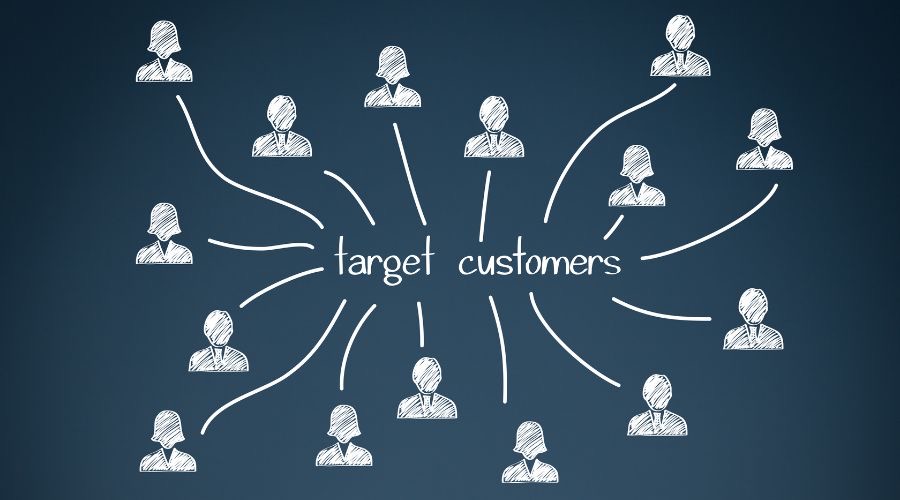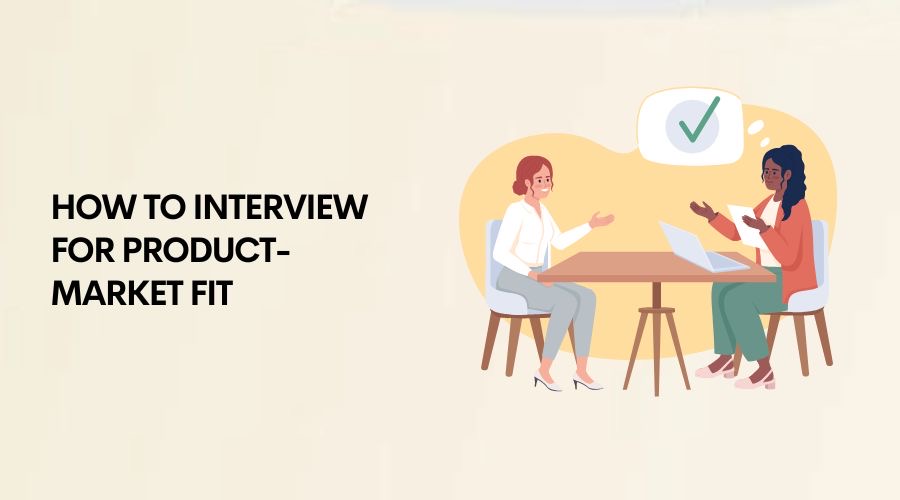Did you know that one of the top reasons why startups fail is that they weren’t able to confirm whether the market wants their new product?
Clearly, you can’t become a successful startup if you don’t have PMF.
You need to find product-market fit to validate your startup and survive in the SaaS or micro-SaaS world.
Fortunately, there are many ways to reach product-market fit. One of them is to learn how to do user interviews.
This step-by-step guide will show you how to interview and talk to customers to find product-market fit.
Let’s begin.
Stage 1: Preparing for Customer Interviews
You have a micro-SaaS product idea, but you’re not yet sure if it’s something your target audience would pay you money for.
The solution: ask your target audience directly.
And for that, you first need to figure out who exactly is a good market to consider.
1. Define target customers

Your job here is to conduct detailed user research and create a specific audience profile.
To this end, you have to collect as many details from them as possible.
Some of the good questions to ask include their demographics, profession, position, age, gender, location, lifestyle, interests, dislikes, pain points, day-to-day struggles, and solutions they currently use.
To collect all this data, research places where your ideal customers hang out, such as Quora threads, subreddits, online forums, Slack communities, and Facebook groups.
Ensure you’re in the right community (e.g., if your product solves a Facebook-related problem, look for communities where people talk about Facebook). Read through conversations and collect information you can use for product development.
But don’t talk to these people just yet. What you’re still doing at this step is gathering data to create a clear profile of your potential customers.
If you find some people talking about the exact problem your B2C or B2B product solves, take note of them. They can become your interviewees in the later steps.
Once you’ve gathered enough data, find what’s common about them and convert the information into critical insights.
2. Identify key questions you can ask
Now that you’ve gained your customers’ information, you need to ask the right questions.
After all, people are busy.
You wouldn’t want to waste your time nor theirs, so you need to keep the conversation short and straight to the point by asking specific questions.
Take note that every question in your arsenal should add further insight into the information you already have.
Here are some examples of questions you can ask:
- What problem do they face that your product solves?
- How significant is that problem for them?
- What’s driving them to solve their problem? Why are they trying to solve it?
- What solutions are they using to solve this problem?
- How are these solutions lacking?
- What features would make these solutions better?
The key is to include interview questions about the problem rather than the suggested solution.
That is, your questions should encourage the people you talk to, to speak in an unbiased manner instead of making them feel like they’re listening to another sales pitch.
3. Choose an interview format
Once you have your questions, the next steps include deciding on the format of your customer interviews.
Do you want to have a one-on-one conversation with each individual or go on in-person meetings?
Consider your audience size and how much time you, your product team, or your marketing team can dedicate to conducting interviews.
4. Find the right people for your user interviews
Once you’ve decided on the previous steps, it’s time to invite interviewees to whom you can start asking your questions.
Now is also a good time to invite every customer you found suitable from step 1.
Just note that for this step, what you want is to interview serious people.
So, it doesn’t have to invite many customers as long as their problem or experience is relevant to your business.
Stage 2: Asking the Right Interview Questions
By now, you may already have scheduled enough interviews.
In this stage, therefore, you need to learn to talk to customers to clearly identify their pain points and figure out whether people are willing to invest in a startup idea like yours.
Here are some interviewing tips you can follow:
1. Build rapport and ensure they get a very pleasant customer experience

Considering that they kindly agreed to your request for a product-market fit interview, it is vital, therefore, that you make them feel welcome.
Don’t start asking questions immediately. Instead, begin by greeting them.
For example, you can ask them how their day has been or offer them a drink before getting down to business.
Doing this will set the tone for your dialogues.
2. Ask open-ended, follow-up questions and listen actively
It doesn’t matter whether the person in charge of your product-market fit research is you or your product manager or the one who does the product strategy.
What’s important at this step is to keep the conversation going with the respondents of your research interviews.
To this end, let them talk.
Keep asking open-ended questions that will give them opportunities to speak their mind about the personal or business problem they’re experiencing which you’re trying to solve.
Keep your ears open throughout the conversation and take notes of the phrases or ideas that they seem to repeat.
This will give you key pieces of information you might be able to use later on for your CRM.
3. Thank them for their time
Once you’ve asked for confirmation and are sure that the information you got will help you make customer success a reality using your product idea, make sure to give your respondents a token of appreciation for their time.
One of the best ways you can do this is by offering unique gifts that they find useful or will make them feel good.
Stage 3: Analyzing the Interview Data Post-Market Survey (PMS)
After stage two, it’s likely that you’ll have much information to go through.
This stage is what the next step is all about: analyzing the data you gathered from your interviews.
In line with that, be sure to focus on these three things:
1. Identify common patterns and themes
Analyzing each customers’ answers to your questions will help you identify common patterns or themes from your ideal market.
For example, the CEO of Carrd figured out that most solopreneurs don’t know how to set up a fancy website. And even if they did, they didn’t want to do it.
Instead, what they need is a simple one-page website to showcase their work and portfolio.
And that’s how he created a perfect solution, and Carrd was born.
2. Categorize the feedback you got

It’s not as simple as finding just a common theme, though.
In fact, you might notice that your research respondents talked about a lot of different needs.
While each need can become a great feature for your existing product idea, you’ll want to find what they need most.
This will become your key feature that separates the user experience for your micro-SaaS idea from other similar products that already are in the market.
3. Synthesize the insights
Since you’ve already gotten feedback and analyzed them, you now need to convert all this data into key insights.
Go through the feedback you got again and collect four to five specific market problems.
These will form as the bases for your minimum viable product.
Stage 4: Working on Your Value Proposition

Now that you’ve gone through the qualitative data you have, you might already understand what kind of software makes the best fit for your ideal market.
Use that to identify the specific use case most of your respondents were concerned about.
Add it in your MVP and launch it publicly.
Also, remember the key phrases you were able to identify during your interviews?
It’s time to use them for your sales and marketing workflow.
Adjust your message in your landing page wireframes and position your product as the best solution.
It may also be a good time to redefine your audience persona and experiment with different pricing strategies to get the most signups.
Whatever it is you want to work on at this stage, you need to prioritize testing your MVP so you can continuously improve it.
This will make it easier for you to prevent your clients from feeling somewhat disappointed or even very disappointed, they would spread negative word of mouth about you.
FAQs on Interviewing People to Find Product-Market Fit
Why is it important to reach product-market fit?
It is essential to ensure your business’s profitability. After all, you can only expect people to willingly pay money when you have a product that solves a primary need for a good market.
What should you do after you’ve found a fit?
Let’s be real: the process requires time, and your product wouldn’t turn perfect even if you’ve found a fit. The world is changing fast, and so do your audience’s needs. Thus, you must keep receiving feedback and improving your product to keep delivering what the market wants.
Why is it crucial to interview people for PMF?
Interviewing people helps you probe deeper and understand the problem more. By interviewing people, you’re not assuming things. Instead, you’re confirming your speculations or discovering new facts you might’ve missed. You’ll get to the core of the problem only when you listen to people with real experience.
Final Thoughts on Interviewing People for Your Micro-SaaS PMF
Learning how to interview your ideal customers for product-market fit is a crucial step you shouldn’t overlook.
This is because the more you understand them, the better the software you’ll create and the more willing they will be to pay for it.
Most people mistake finding product-market fit as a one-time thing, but it’s actually not.
You need to keep receiving feedback and improving your product.
That doesn’t mean you have to do it alone, though.
At Symalite Labs, we help aspiring SaaS and micro-SaaS entrepreneurs launch their startup ideas and build profitable businesses.
Our portfolios include GroupLeads, Chatsilo, Orrderly, and even Vidscout.
Give us a nudge, and let’s discuss how we turn your software ideas into a reality!

